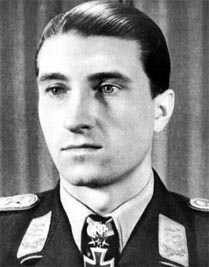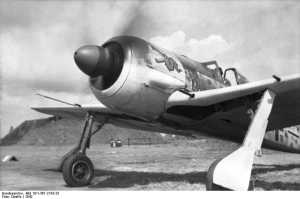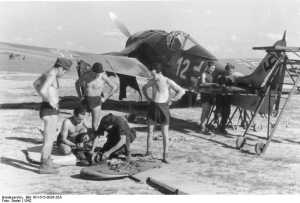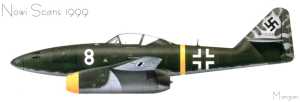Walter Nowotny
German Luftwaffe Ace, Fw 190 and Me 262 pilot
By Stephen Sherman, Sept. 2002. Updated July 7, 2011.
One of the highest scoring German aces (an Austrian, actually) almost ended his flying career very early.
Flying a Bf 109 in July 19, 1941, he had shot down three Polikarpov I-153 biplanes (his first three kills), when he went down too. He ditched his Messerschmitt in the Gulf of Riga and clambered into his one-man survival raft. With no food or drink, he paddled southwards, towards land that he estimated to be about 40 miles away. A couple German fighters flew overhead, but didn't notice his Mauser pistol shots. Sunburn set in, waves splashed into his dinghy, and he became exhausted from his paddling.
On his second night adrift, two Soviet destroyers passed close by, but didn't notice him either.
He was somewhat heartened by the evidently-German artillery fire directed at the Russian warships. But by the second day, he became nearly suicidal, and even began writing a "farewell message." He fell asleep, and when he awoke on the third day, the currents had brought him close to shore. He paddled towards it, landed, and collapsed on the sandy beach. He awoke in a bed; two Latvian auxiliaries (collaborators?) had rescued him.
For many months, JG 54 remained at Krasnogvardeisk, as the northern front settled into a stalemate around besieged Leningrad.
Messerschmitt Bf 109
Nowotny achieved over 50 victories in this airplanes, from July 1941 through early 1943. He was appointed Staffelkapitän of 1./JG 54 on 25 October 1942.Focke Wulf 190
In January and February of 1943, JG 54 transitioned to the Fw 190, a rugged aircraft that Nowotny and many othe experten would fly with great success. In August, Nowotny added 49 victories to his score and was promoted to Gruppenkommandeur of 1./JG 54. Heady stuff for a 22-year-old. But he hadn't yet been awarded the "Oak Leaves," and showed distinct signs of "throat-ache;" despite the fact that he had passed the 120-victory threshhold - no "Oak Leaves."
But he continued to excel in the air. On September 1, 1943 he downed ten Russian aircraft. On a morning bomber escort mission, he destroyed four attacking Soviet fighters. He noticed another group, and promptly got two of those. As the dogfight carried him 180 km over Russian lines, he closed in on a seventh victim, only to have his cannon jam. he closed in ever closer and finished it off with his machine guns. He made good his return by flying on the deck, right through the flak thrown up from a large town. That afternoon, on another sortie, he got three more during an in-and-out duel in the clouds.
A few days later, he received his long-awaited Oak Leaves. "The Swords" followed three weeks later, awarded to him at a ceremony at Hitler's headquarters.
By September 14, his score stood at 203, just behind the Luftwaffe leader (Hans Phillipp?). At midday, on a clear, perfect day, Soviet bombers and their fighter escorts approached. Nowotny led his 4-plane Schwarm on a Freie Jagd (literally "free hunt," or in Allied aviation jargon, a "fighter sweep"). Soon, everyone in the ops room heard over the loudspeaker his radio call that he had achieved his 204th. He was then the top Luftwaffe experte. He kept flying and fighting and shooting down Soviet planes. Before the end of September, he had reached a total of 235. On afternoon, while patrolling south of Velikiye Luki, he shot down 3 of a group of 14 Airacobras. The next day, in the same area, a flight of 6 Airacobras fled as soon as they sighted the Fw 190's; perhaps they were survivors from the previous day's mission. Only two escaped.
Then he had a day ruined by jammed guns and an out-of-service aircraft. The following day, his aerial rampage continued: two P-40s, a P-39, and an LaGG-3. Nowotny was doing his part to reduce the American Lend-Lease equipment sent to Russia.
The Diamonds
On October 15, 1943, he destroyed a Curtiss P-40 - his 250th victory. He was the first pilot ever to achieve such a score. Back at his base, a wild celebration ensued. Nowotny took off to Vilna to celebrate in style. His wingman "Quax" Schnörrer stayed at the base and, with other pilots, got riotously drunk. Then General von Greim telephoned, to say that the Führer wanted to speak to Nowotny, to congratulate him personally. Understanding the situation, General Greim passed on the information that Nowotny was at the Ria Bar in Vilna, confident that Hitler's telephone operators wouldn't be able to get through to the partying Nowotny. But they did. Nowotny, stewed to the gills, surrounded by young lovelies in a noisy bar, managed to get through the conversation with the Führer. He had been awarded the "Diamonds," the Reich's highest military honor. The next day, von Greim, Schnörrer, and Nowotny flew to Hitler's HQ in East Prussia, for Nowotny to receive his "Diamonds."
But October, 1943 marked the end of Nowotny's famous schwarm (flight of four planes). Toni Döbele (96 victories) was killed. Lt. Karl "Quax" Schnörrer (35) was badly injured in a crash and hospitalized for a long time. Nowotny himself was made into a superhero by Goebbels propaganda machine and was withdrawn from the front.
Training Assignments
His career was temporarily halted because he was assigned command of the Schulegeschwader 101 (SJG 101). This was a training unit for new pilots, and was based in Palau. Even though it was an unpopular assignment for the veteran pilots, Nowotny once again brilliantly succeded, earning a reputation as a first class instructor.
Me 262 Jet
On September 26, 1944, he was appointed CO of Kommando Nowotny, the world's first jet fighter unit, based at Achmer and Hesepe
Kommando Nowotny became operational on the 3rd of October and claimed their first kill, a B-24, on October 7th. Nowotny began the practice of using prop-driven conventional fighters as cover against the roaming Allied fighters during the takeoffs and landings of the Me 262. The Me 262 was especially vulnerable as the turbojet's relatively low thrust resulted in slow acceleration. It took some time for the jet to get up to speed. But once there, no Allied aircraft could touch it.
Adolph Galland, Luftwaffe General of Fighters, visited Achmer for an inspection. Nowotny was going to give Galland his pilots' flight reports. A flight of B-17 bombers was reported, so the unit took off, about six jets in the first wave, then another. The Fw-190Ds were waiting on the runway cover their return of the jets. Galland was in the operations shack, monitoring the pilots' radio transmissions. Several bombers were called out as shot down, and Nowotny radioed that he was approaching. The flight leader on the ground, Hans Dortenmann, requested permission to take off to assist, but Nowotny said no, to wait. The defensive anti-aircraft battery opened fire on a few P-51 Mustangs that approached the field, but they were chased away.
The jets were coming in.
One Me-262 had been shot down, and Nowotny reported an engine failure before making a garbled transmission referring to "burning". Galland watched Nowi's approach, heard the sound of a jet engine, and saw his Me 262 A-1a (W.Nr. 110 400) "White 8" dive vertically out of the clouds and crash at Epe, 2.5 kilometres east of Hesepe. The explosions rocked the air, and only a column of black smoke rose from behind the trees. The wreckage was Nowotny's plane. After sifting through it, the only salvageable things found were his left hand and pieces of his Diamonds decoration.
The unit was disbanded shortly after Nowotny's death. It had claimed 22 aircraft with a loss of 26 Me 262s, eight of which were due to accidents and mechanical failures.
Sources:
- German
Jet Aces of World War 2 (Osprey Aircraft of the Aces No 17), by
Hugh Morgan, John Weal
- Focke-Wulf Fw 190 Aces of the Russian Front (Osprey Aircraft of the Aces, No 6), by John Weal
- The
First and the Last by Adolph Galland. This book is a history of
the air war over Europe from the German perspective, with a fair amount
devoted to aircarft development, internal Luftwaffe problems, and such
events as the Channel Dash. Even the Russian campaign and the American
bombing strategy are surveyed. Relatively little on Galland's personal
activities, dogfights, etc.
- Walter "Nowi" Nowtny webpage
- Me 262 page
- The Aces Talk (originally titled Fighter Tactics and Strategy, 1914-1970), by Edward Sims, Ballantine Books, 1972
- Rand McNally Encyclopedia of Military Aircraft: 1914-1980, by Enzio Angelucci, The Military Press, 1983




